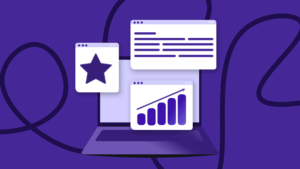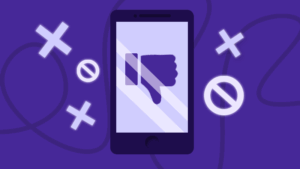What Is Q5? And Why You Should Definitely Plan a Q5 Campaign
After bouncing around tech start-ups and university literature programs, Joe has finally settled down as Billo’s Head of Content. Joe now spends his days writing ads about ads, teaching clients how to craft killer content, and combing through our web copy with a bold red Sharpie.

It’s easy to lose yourself in the dazzling world of digital marketing, where algorithms change as swiftly as trends. It’s near impossible lately to know which “new thing” is the real deal.
That said, one term cuts through all the flashy jargon and hype-train noise – Q5.
You might have heard something about its efficacy and potential, but what exactly is Q5 digital marketing, why should this “hidden quarter” be on your radar, and why even plan a Q5 campaign at all?
In this article, we aim to demystify the concept of Q5 and unravel the reasons why planning a Q5 campaign is not just a good idea but a strategic imperative in the contemporary marketing arena.
Understanding Q5 Digital Marketing
Q5—two characters that hold the promise of revolutionizing your digital marketing strategy. But what does Q5 really mean?
Originating from the rapid advancements in technology and the evolving expectations of consumers, Q5 signifies the fifth quadrant in the digital marketing matrix, an area that goes beyond the conventional realms of online promotion.
We’ll explore the roots of Q5 and how it has emerged as a game-changer in the digital marketing playbook.
Q5 isn’t just a fleeting trend; it’s a holistic approach to digital marketing that incorporates a diverse set of features and components.
From harnessing the power of artificial intelligence to creating personalized user experiences, Q5 is a multifaceted strategy designed to engage and captivate. We’ll dissect the key features and components that make Q5 a force to be reckoned with in the digital marketing arena.
How does Q5 differ from traditional marketing approaches?
In a world where change is the only constant, sticking to traditional marketing approaches might feel like treading water—exerting effort but not making progress.
Q5 breaks away from the conventional molds of marketing, embracing a dynamic and adaptive methodology that resonates with the modern consumer. We’ll uncover the distinctive aspects of Q5 that set it apart from traditional marketing approaches, showcasing why it’s the evolution your brand needs.
The Benefits of Incorporating Q5 into Your Marketing Strategy
Why should your business jump on the Q5 bandwagon? The benefits are as numerous as the pixels on your digital screen.
Incorporating Q5 into your marketing strategy isn’t just a trend; it’s a strategic move that can redefine your brand’s relationship with its audience. From enhanced customer experiences to optimized marketing budgets, the advantages are manifold.
First and foremost, Q5 campaigns bring a level of personalization that resonates with today’s discerning consumers.
Tailoring content and offers based on individual preferences and behaviors create a sense of connection that transcends the transactional. This personalized touch isn’t just a nicety; it’s a competitive edge that fosters brand loyalty and customer advocacy.
Moreover, the data-driven nature of Q5 empowers marketers with insights that were once the stuff of dreams.
Understanding consumer behavior, predicting trends, and adapting in real-time—Q5 is the key that unlocks the door to a marketing utopia where decisions are informed, and strategies are agile.
Planning Your Q5 Campaign
Where to start this Q5?
Setting Clear Q5 Objectives and Goals
Embarking on a Q5 campaign without a clear destination is akin to sailing without a compass. To harness the true power of Q5, start by setting crystal-clear objectives and goals.
What do you want to achieve? Increased brand awareness? Boosted conversions? Enhanced customer engagement? Define your objectives with specificity and ensure they align with your overall business strategy.
Consider the SMART criteria – Specific, Measurable, Achievable, Relevant, and Time-bound. For instance, instead of a vague goal like “increase engagement,” aim for a specific 20% rise in user interactions on your social media platforms within the next three months.
Clear objectives not only provide a roadmap but also serve as benchmarks to measure the success of your Q5 campaign.
Identifying Target Audiences for Q5 Campaigns
In the big picture of digital marketing, the shotgun approach rarely hits the mark. Q5’s effectiveness lies in its ability to tailor experiences to the individual, making it imperative to identify and understand your target audience.
Who are your customers? What are their preferences, pain points, and behaviors? Conduct thorough market research and utilize data analytics to create detailed buyer personas.
By honing in on specific demographics, psychographics, and behavioral traits, you can personalize your Q5 campaign to resonate with your audience on a deeper level.
Remember, the more accurate your targeting, the more meaningful your interactions, and the higher the likelihood of achieving your campaign goals.
Crafting a Compelling Q5 Marketing Strategy
With objectives defined and target audiences identified, it’s time to craft a compelling Q5 marketing strategy. This isn’t a one-size-fits-all scenario; it’s about tailoring your approach to meet the unique needs and expectations of your audience. Consider the following elements:
- Personalization Techniques: Leverage data to personalize content, offers, and interactions. From personalized emails to dynamically generated website content, the possibilities are vast.
- Multichannel Integration: Q5 isn’t confined to a single channel. Integrate your Q5 strategy across various touch points and UGC platforms – social media, email, website, and beyond – to create a seamless, immersive experience.
- Predictive Analytics: Anticipate customer behavior with predictive analytics. Identify patterns, forecast trends, and stay one step ahead in meeting your audience’s evolving expectations.
- Agile Adaptation: The digital landscape is dynamic. A compelling Q5 strategy is one that adapts in real-time. Monitor performance metrics, gather feedback, and be ready to pivot when necessary.
Tools and Techniques for Q5 Success
You’re only as good as your tools when it comes to digital marketing. This is even more true for nailing your Q5 campaign.
Utilizing Technology and Data Analytics
At the heart of any successful Q5 campaign lies the seamless integration of cutting-edge technology and the insightful analysis of data. The marriage of these two elements empowers marketers to not only understand their audience but to predict and respond to their needs in real-time.
- Data Analytics Platforms: Invest in robust data analytics platforms that can sift through vast datasets, providing valuable insights into consumer behavior, preferences, and trends. By leveraging data analytics, marketers can make informed decisions, refine their strategies, and optimize campaigns for maximum impact.
- Artificial Intelligence (AI): Embrace the power of AI to unlock the full potential of Q5. Machine learning algorithms can analyze user behavior patterns, predict future actions, and automate personalized content delivery. Whether it’s chatbots offering tailored assistance or recommendation engines suggesting products, AI is a game-changer in the Q5 landscape.
- Predictive Modeling: Anticipate the future by implementing predictive modeling techniques. By analyzing historical data, marketers can forecast trends, identify potential opportunities, and stay ahead of the curve in a rapidly evolving digital marketplace.
Social Media Integration in Q5 Campaigns
In the age of interconnectedness, social media is more than just a platform for sharing memes and updates—it’s a vital component of any Q5 campaign.
Integrating social media into your Q5 strategy ensures that your brand is not just present but actively engaged in the conversations that matter to your audience.
- Real-time Engagement: Social media platforms provide a real-time avenue for interaction. Whether it’s responding to customer queries, addressing concerns, or capitalizing on trending topics, real-time engagement is the heartbeat of a successful Q5 social media strategy.
- Targeted Advertising: Leverage the robust targeting options offered by social media platforms. From demographic targeting to custom audience segmentation, precision is key. This ensures that your Q5 messages reach the right audience at the right time.
- User-Generated Content: Encourage user-generated content to enhance authenticity and create a sense of community. Q5 is not just about what you say to your audience but also about what your audience says about you. User-generated content adds a human touch to your brand.
Incorporating Personalized Experiences for Users
The cornerstone of Q5 is the ability to deliver personalized experiences that resonate with individual users. From tailored product recommendations to customized messaging, the art of personalization is what sets Q5 campaigns apart.
- Dynamic Content Creation: Craft dynamic content that adapts based on user behavior and preferences. Whether it’s a personalized homepage or email content that changes with each open, dynamic content creation ensures that every interaction is relevant and meaningful.
- Behavioral Trigger Campaigns: Set up behavioral triggers that initiate specific actions based on user interactions. For instance, an abandoned cart email triggered by a user’s inactivity can reignite their interest and lead to a conversion.
- Personalized Email Campaigns: Move beyond generic email blasts. Utilize data to tailor email campaigns, addressing users by name, recommending products based on past purchases, and acknowledging milestones in their customer journey.
Overcoming Challenges in Q5 Marketing
While the potential for success is immense, so too are the challenges that may arise along the way. Understanding common pitfalls and dispelling misconceptions is key to navigating the Q5 landscape with finesse.
- Overreliance on Technology: One common pitfall is the overreliance on technology at the expense of human insight. While AI and data analytics are powerful tools, they should complement, not replace, the human touch in marketing. Striking the right balance ensures that Q5 campaigns retain a genuine and relatable aspect.
- Data Privacy Concerns: As Q5 relies heavily on data analytics, navigating the intricate landscape of data privacy is crucial. Failing to address concerns regarding user data can lead to backlash and erode trust. Transparency and a robust data protection strategy are paramount in overcoming this challenge.
- Lack of Personalization Finesse: Personalization is the hallmark of Q5, but executing it poorly can backfire. Generic attempts at personalization, such as using the wrong name or recommending irrelevant products, can alienate rather than engage. Precision and attention to detail are essential to avoid falling into this common pitfall.
Strategies for Mitigating Risks in Q5 Campaigns
No promotion is without its challenges, but with strategic planning and proactive measures, the risks associated with Q5 campaigns can be effectively mitigated.
- Robust Data Security Measures: Prioritize data security controls by implementing robust measures to protect customer information. Encrypting data, ensuring compliance with privacy regulations, and regularly auditing security protocols are essential steps in building and maintaining trust.
- Continuous Monitoring and Adaptation: Q5 is dynamic, and so should be your approach. Implement real-time monitoring of campaign performance, user feedback, and market trends. Being agile in response allows you to address issues promptly, optimize strategies, and stay ahead of potential challenges.
- User Feedback Integration: Actively seek and integrate user feedback into your Q5 campaigns. Users are the best source of information on what works and what doesn’t. By listening to their insights, you can identify areas for improvement, refine your personalization strategies, and enhance the overall user experience.
Learning from Failures and Adapting for Future Success
Failure is not the end but rather a stepping stone to success. In the realm of Q5 marketing, learning from failures is as crucial as celebrating victories.
- Post-Campaign Analysis: After each Q5 campaign, conduct a thorough post-mortem analysis. Identify what worked well, what fell short, and why. This retrospective examination provides valuable insights into the efficacy of your strategies and informs future decision-making.
- Cultivating a Culture of Adaptability: In the ever-evolving digital landscape, adaptability is a cornerstone of success. Foster a culture within your team that embraces change, values learning from mistakes, and views challenges as opportunities for growth. This mindset positions your brand to thrive in the face of uncertainty.
- Iterative Improvement: Q5 marketing is an iterative process. Use the knowledge gained from both successes and failures to refine and enhance your strategies continually. Each campaign is a building block, contributing to a more nuanced and effective approach over time.
Practical Tips for Executing a Q5 Campaign
Q5 campaigns are great in theory, but what about in practice. Below are some practical tips from taking your end-of-the-year campaign from the drawing board to result-making reality.
Step-by-Step Guide to Implementing a Q5 Strategy
Implementing a Q5 campaign requires meticulous planning and execution. Here’s a step-by-step guide to help you navigate the intricate process of bringing your Q5 strategy to life:
- Define Clear Objectives: Clearly outline the objectives of your Q5 campaign. What specific outcomes do you want to achieve? Whether it’s increased engagement, higher conversion rates, or improved brand loyalty, having well-defined objectives sets the foundation for success.
- Comprehensive Audience Analysis: Conduct in-depth audience research to create detailed buyer personas. Understanding your audience’s preferences, behaviors, and pain points is crucial for tailoring personalized experiences.
- Select Appropriate Technology: Choose the right technology and tools to support your Q5 strategy. Whether it’s AI-powered analytics platforms, customer relationship management (CRM) systems, or personalization engines, ensure that your tech stack aligns with your campaign goals.
- Personalization Blueprint: Develop a blueprint for personalization. Map out how you will tailor content, recommendations, and interactions based on user data. Consider customer touchpoints across various channels to ensure a cohesive and personalized journey.
- Multichannel Integration: Integrate your Q5 strategy seamlessly across multiple channels. Whether it’s email, social media, or your website, consistency in messaging and personalization enhances the user experience.
- Agile Execution: Adopt an agile approach to execution. Q5 is dynamic, and the ability to adapt in real-time is a significant advantage. Be ready to pivot based on campaign performance, user feedback, and emerging trends.
Resources and Tools for Optimizing Q5 Campaigns
To optimize your Q5 campaigns, leverage a toolkit of resources and tools designed to enhance efficiency and effectiveness:
- Data Analytics Platforms: Again, invest in advanced data analytics platforms to gain actionable insights into user behavior. Platforms like Google Analytics, Adobe Analytics, or custom solutions can provide the data foundation for your Q5 strategy.
- AI and Machine Learning Tools: Harness the power of AI and machine learning for predictive analytics, behavior analysis, and personalized content recommendations. Tools like TensorFlow, IBM Watson, or custom-built algorithms can elevate your Q5 campaigns.
- Personalization Engines: Explore personalization engines that automate the delivery of tailored content. Solutions such as Dynamic Yield, Evergage, or custom-built personalization engines can enhance user experiences across channels.
- CRM Systems: Integrate Customer Relationship Management (CRM) systems to centralize customer data. Salesforce, HubSpot, or other CRM tools streamline customer interactions and contribute to a comprehensive view of your audience.
- Social Media Management Tools: Employ social media management tools for streamlined execution and monitoring. Platforms like Hootsuite, Buffer, or Sprout Social enable efficient social media integration within your Q5 strategy.
Best Practices for Continuous Q5 Improvement
Q5 marketing is a process, not a one-and-done promo. Continuously refine and improve your strategies with these best practices:
- Regular Performance Analysis: Conduct regular performance analyses to assess the effectiveness of your Q5 campaigns. Identify key performance indicators (KPIs) and use them to measure success against your defined objectives.
- User Feedback Integration: As mentioned before, actively seek and incorporate user feedback. Whether through surveys, social media interactions, or direct communication, user insights are invaluable for refining personalization strategies and addressing pain points.
- A/B Testing: Implement A/B testing to experiment with different elements of your Q5 campaigns. Test variations in messaging, content, and personalization approaches to identify what resonates most with your audience.
- Stay Updated on Technology: The digital landscape evolves rapidly. Stay informed about emerging technologies, trends, and tools relevant to Q5 marketing. Regularly assess and update your tech stack to stay at the forefront of innovation.
- Collaborate Across Teams: Foster collaboration between marketing, data analytics, and IT teams. Q5 success is a cross-functional effort that requires alignment and synergy between different departments within your organization.
Measuring Success and Effectiveness of Q5 Campaigns
When it comes to Q5 campaigns, success isn’t a nebulous concept—it’s measurable, tangible, and deeply tied to the return on investment (ROI).
Understanding how to gauge the success and effectiveness of your Q5 campaigns is crucial for optimizing strategies and proving the value of your efforts.
- Key Performance Indicators (KPIs): Define and track specific KPIs aligned with your campaign objectives. Whether it’s increased engagement, conversion rates, or customer retention, having quantifiable metrics provides a clear picture of success.
- User Interaction Analytics: Dive into user interaction analytics to understand how your audience engages with personalized content. Analyzing click-through rates, time spent on pages, and conversion paths helps in fine-tuning personalization strategies for optimal results.
- Conversion Funnel Analysis: Break down the conversion funnel to identify strengths and weaknesses in your Q5 campaign. Assess how personalized experiences impact each stage of the funnel, from awareness to conversion, and optimize accordingly.
Comparing Q5 ROI with Traditional Marketing Approaches
While traditional marketing approaches have their merits, comparing the ROI of Q5 campaigns with these methods often reveals a paradigm shift in effectiveness and efficiency.
Q5 campaigns, with their emphasis on data-driven personalization, enable precision targeting. Unlike broad-reaching traditional methods, Q5 allows you to tailor messages to specific segments, minimizing wasted resources and maximizing ROI.
Q5’s personalized experiences foster deeper connections with customers. When compared to generic, mass-market campaigns, the heightened engagement achieved through Q5 translates to more meaningful interactions and, subsequently, a higher ROI.
Traditional marketing approaches can be rigid and slow to adapt. Q5, on the other hand, thrives on agility. The ability to pivot in real-time based on user behavior and market trends enhances campaign responsiveness, positively impacting ROI.
Calculating the Long-Term Impact of Q5 Campaigns
Effective ads are the best ads and Q5 campaigns aren’t just about immediate returns; they lay the groundwork for sustained success in the long run. Calculating the long-term impact involves looking beyond short-term gains and considering the lasting effects on brand equity and customer loyalty.
- Brand Loyalty and Advocacy: Measure the growth of brand loyalty and customer advocacy stemming from Q5 campaigns. By delivering personalized experiences that resonate, Q5 has the potential to create loyal customers who become advocates, contributing to sustained revenue over time.
- Customer Lifetime Value (CLV): Evaluate the impact of Q5 on CLV—a metric that gauges the total value a customer brings throughout their relationship with your brand. Q5’s ability to nurture ongoing, personalized interactions can significantly enhance CLV compared to one-size-fits-all approaches.
- Market Differentiation: Consider the long-term impact of Q5 on your brand’s position in the market. The ability to deliver superior, personalized experiences sets your brand apart, contributing to a positive reputation, customer trust, and increased market share over time.
Q5 and the Future of Digital Marketing
Digital marketing is in a perpetual state of evolution. As we look toward the future, it’s not just a question of what Q5 is doing for us now, but how it is poised to shape the very fabric of the marketing industry.
Emerging Trends in Q5 Marketing
- AI and Predictive Analytics: The symbiosis between Q5 and artificial intelligence is destined to deepen. The use of predictive analytics, powered by AI algorithms, will become even more sophisticated. We can anticipate AI not just reacting to user behavior but proactively predicting needs, revolutionizing the personalization game.
- Immersive Experiences with AR and VR: Q5 isn’t limited to the confines of a screen. The future sees the integration of augmented reality (AR) and virtual reality (VR) in Q5 campaigns. Imagine users interacting with products in a virtual space or experiencing services through AR-enhanced apps—personalization will transcend the digital divide.
- Voice Search Optimization: With the rise of voice-activated devices and smart assistants, Q5 strategies will increasingly focus on optimizing for voice search. Brands will need to adapt their content and experiences to align with the nuances of voice-driven interactions, offering a more personalized and conversational touch.
- Cross-Channel Consistency: Q5 isn’t confined to a single channel. It seamlessly integrates across various touchpoints, creating a consistent brand experience. This alignment with a cross-channel approach resonates with the evolving consumer who expects cohesive interactions regardless of the platform.
- Emphasis on Ethical Personalization: As personalization becomes more ingrained in digital marketing, the ethical use of customer data will be paramount. Q5 strategies will align with privacy regulations, ensuring that personalization enhances user experiences without compromising trust.
The Future Importance of Q5 Ad Campaigns
Q5 is a wonderful example of marketing innovation and strategic imperative. The efficacy and potential of Q5 extend beyond mere trends—it’s a transformative force that aligns with the dynamic expectations of today’s consumers.
The strategic importance of planning a Q5 campaign is not just about staying afloat at the end of the year; it’s about charting a course towards unparalleled success in the contemporary marketing arena.
As algorithms continue to evolve, Q5 stands poised to be not just a trend but a linchpin for brands aiming to navigate the digital currents and forge lasting connections with their audience.
In the fast-approaching future of digital marketing, Q5 isn’t just an option; it’s the imperative that propels brands towards the forefront of ad innovation and customer-centricity.
Continue learning:
Head of Content
After bouncing around tech start-ups and university literature programs, Joe has finally settled down as Billo’s Head of Content. Joe now spends his days writing ads about ads, teaching clients how to craft killer content, and combing through our web copy with a bold red Sharpie.

Authentic creator videos, powered by real performance data
22,000+ brands use Billo to turn UGC into high-ROAS video ads.
When to Trust Data-Driven Suggestions (and Whe...
Platforms, dashboards, and AI tools now shape nearly every marketing [...]...
Read full articleThe Power of Content Seeding: How to Plant Your ...
Content distribution has shifted — dramatically. Today, 70% of B2B [...]...
Read full article10 Common Digital Marketing Mistakes to Avoid in...
Digital marketing is fast, and what worked years ago might [...]...
Read full article



